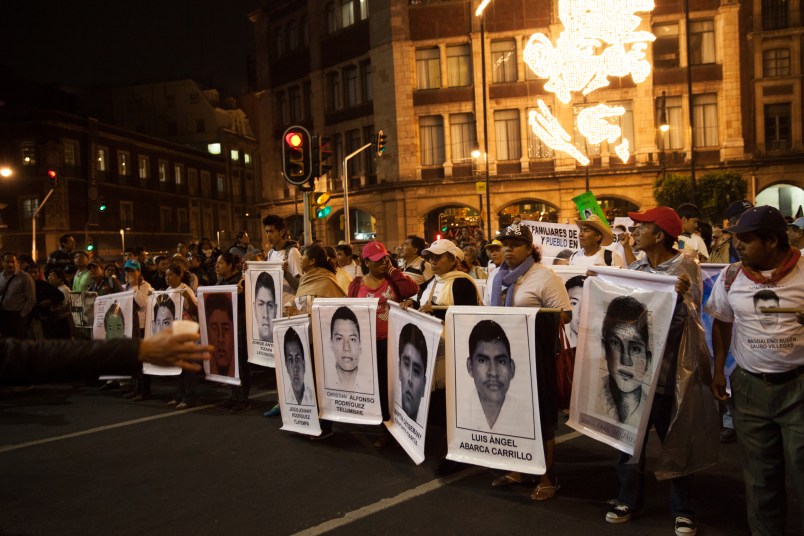MEXICO CITY (AP) — A largely peaceful march by tens of thousands demanding the return of 43 missing students ended in violence, as a small group of masked protesters battled police in Mexico City’s main square.
The march late Thursday sought the return of the students from a rural teachers’ college. Nov. 20 is usually a day reserved for the celebration of Mexico’s 1910-17 Revolution, but Mexicans were in no mood for celebrations.
Many of the marchers carried “mourning” flags with Mexico’s red and green national colors substituted by black stripes.
“The entire country is outraged,” said housewife Nora Jaime. “It is not just them,” she added, referring to the 43 young men who haven’t been seen since being attacked by police in a southern city Sept. 26. “There are thousands of disappeared, thousands of clandestine graves, thousands of mothers who don’t know where their children are.”
The march in Mexico City was mostly peaceful, in contrast to recent protests that have ended with the burning of government buildings in Guerrero state, where the students disappeared. Whenever masked protesters tried to join Thursday’s march, demonstrators shouted them down with chants of “No violence!” and “Off with the masks!”
The protesters converged on the city’s main square, where families of the missing students stood on a platform in front of the National Palace holding posters of their relatives’ faces. Amid chants for President Enrique Pena Nieto to step down, family members repeated that they do not believe the government’s account that the youths were killed by a drug gang,
“We’re not tired,” said one man speaking from the platform. “On the contrary, we are mad with this Mexican government and its entire structure, because it has not done anything but deceive the families.”
After most of the protesters left the square, a small group of masked youths began battling police with rocks and sticks. Police responded with fire extinguishers to put out fires set by the youths and to force them off of the square.
Police charged across the square to drive the protesters out. At least two news photographers, including one from The Associated Press, were injured by police, who took two cameras and some lenses from the AP photographer.
Earlier in the day, about 200 youthful protesters, some with their faces covered by masks or bandanas, clashed with police as they tried to block a main expressway to the international airport. Protesters hurled rocks, fireworks and gasoline bombs at the police, at least one of whom was hit by the projectiles. Some passengers had to walk to the terminal, but flights were not interrupted and expressways were reopened.
Many average people, outraged by the disappearances of the students, turned out for the march despite cool weather and some light rain.
Maria Antonieta Lugo was part of a group of housewives who joined the march “because we have children of the same age” as the missing students, who ranged from their teens to their 20s. “This could happen to our children as well,” she said.
Maria Teresa Perez held up a poster with a picture of her son, Jesus Horta Perez, 45, who was kidnapped by armed men from a storefront in a Mexico City suburb in 2009 and has never been heard from again.
“They are shouting about 43, but they should be counting in the thousands, because apart from these 43, there are 33,000 disappeared,” Perez said.
Mexico officially lists 22,322 people as having gone missing since the start of the country’s drug war in 2006. And the search for the missing students has turned up other, unrelated mass graves.
The 43 students, who attended a radical rural teachers college known as Ayotzinapa, disappeared after they went to the Guerrero city of Iguala to hijack buses. Iguala police intercepted them on the mayor’s orders and turned them over to the criminal group Guerreros Unidos, a gang with ties to the mayor, prosecutors have said. Prosecutors say there is evidence the gang members killed the students and incinerated their remains.
It is that link between a local government and drug gang that disgusts many Mexicans.
“I think the reason people are here today is not just Ayotzinapa,” said one protester, Alejandro Gonzalez, who studied industrial design in Pachuca. “I think that today, more than ever … people are realizing the political structures are rotten, useless.”
Copyright 2014 The Associated Press. All rights reserved. This material may not be published, broadcast, rewritten or redistributed.






